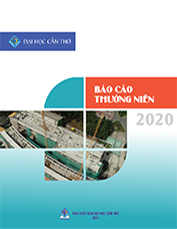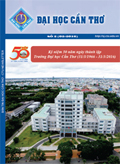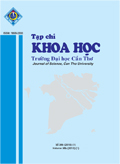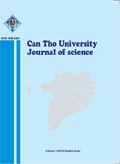Thông tin chung: Ngày nhận bài: 21/09/2019
Ngày nhận bài sửa: 25/10/2019 Ngày duyệt đăng: 25/12/2019 Title: Isolation and identification of fenobucarb degrading bacteria in rice paddy soils Từ khóa: Burkholderia arboris, đất lúa, fenobucarb, Micrrococcus terreus, phân hủy sinh học Keywords: Biodegradation, Burkholderia arboris, fenobucarb, Micrrococcus terreus, rice paddy soil | ABSTRACT Fenobucarb has been widely used to control insects in rice paddy fields. This insecticide is shown to pose toxic effects on aquatic animals due to its inhibition on the normal activity of cholinesterase. This study aimed to isolate, screen and identify indigenous bacteria capable of degrading fenobucarb in the rice paddy soils. Twenty bacterial isolates able to grow on minimal medium supplemented with fenobucarb 100 mg/L as sole carbon source were isolated from eight soil samples collected from rice paddy soils of Co Do and Vinh Thanh district, Can Tho. Two isolates CĐ5.2 and CĐ5.3 obtained from Co Do fields showed the higher fenobucarb degradation with the efficiency of 58.2% and 60.1%, respectively, after nine days of incubation. Based on 16S-rRNA gene sequence analysis and biochemical characterization including activities of gelatinase, urease, oxidase, citrate assimilation and sugar fermentation, isolates CĐ5.2 and CĐ5.3 were genetically identified as Burkholderia arboris CĐ5.2 and Micrococcus terreus CĐ5.3, respectively. TÓM TẮT Hoạt chất fenobucarb được sử dụng phổ biến để diệt rầy nâu trên ruộng lúa. Khi lưu tồn trong đất hoặc bị rửa trôi vào môi trường nước, fenobucarb gây độc đến các loài động vật thủy sinh do làm giảm hoạt tính của enzyme cholinesterase. Nghiên cứu này được thực hiện nhằm phân lập, tuyển chọn và nhận diện các dòng vi khuẩn bản địa trong đất trồng lúa có khả năng phân hủy hiệu quả fenobucarb. Hai mươi dòng vi khuẩn có khả năng phát triển trên môi trường khoáng tối thiểu có bổ sung fenobucarb 100 mg/L như nguồn carbon duy nhất đã được phân lập từ 8 mẫu đất tại huyện Cờ Đỏ và Vĩnh Thạnh, Cần Thơ. Hai dòng vi khuẩn CĐ5.2 và CĐ5.3 được phân lập từ đất trồng lúa ở Cờ Đỏ có khả năng phân hủy fenobucarb hiệu quả hơn so với các dòng còn lại, đạt 58,2% và 60,1% sau 9 ngày nuôi cấy. Dựa vào trình tự gen 16S-rRNA và các đặc điểm sinh hóa như hoạt tính gelatinase, urease, oxidase, đồng hóa citrate và lên men đường, hai dòng vi khuẩn CĐ5.2 và CĐ5.3 được định danh khoa học lần lượt là Burkholderia arboris CĐ5.2 và Micrococcus terreus CĐ5.3. |






